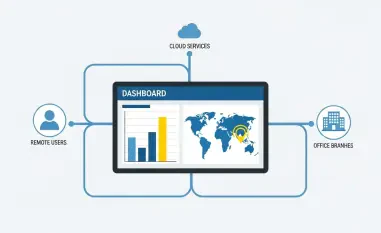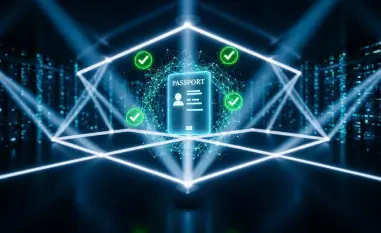The network security landscape is undergoing a significant transformation. With the rise of remote workforces, cloud-based networking, and sophisticated cyber threats, traditional VPN-centric security frameworks are being challenged. Enter Zero Trust security—a framework that could redefine how we protect our data and networks.
The Decline of Traditional Network Security Models
Traditional network security models are increasingly proving inadequate in the face of modern threats. With the rise of cloud computing and mobile workforces, the perimeter that once defined an organization’s security has become blurred. Consequently, organizations must adopt new security paradigms that focus on securing data and user access rather than just the network itself.
The Castle and Moat Approach
For years, the “castle and moat” method of network security has been the standard. This approach creates a strong perimeter to keep threats out, but once inside, there are few barriers to prevent lateral movement. However, the increasing complexity of modern networks and the rise of remote work have exposed the limitations of this model. Remote employees connect from various locations and devices, creating numerous entry points for potential attacks. As a result, the traditional model, which relies on a rigid boundary to separate trusted internal systems from untrusted external threats, is no longer sufficient to protect against sophisticated cyber attackers that leverage these diverse points of entry.
In addition to the difficulties presented by remote work, cloud services further complicate the picture. Data and applications are no longer confined to central, on-premises servers behind a fortified network boundary. Instead, they are dispersed across various cloud providers, making it more challenging to enforce consistent and comprehensive security policies. This shift toward decentralization and increased connectivity demands a new approach to network security, one that moves beyond merely defending perimeters and addresses the inherent vulnerabilities within the network itself.
Challenges of Remote Work and Cloud Services
With remote workforces and cloud-based services becoming the norm, maintaining a secure perimeter has become increasingly difficult. Employees access corporate networks from various locations and devices, creating numerous entry points for potential attacks. Traditional VPNs, while providing a secure connection, do not address the internal security challenges posed by these new working environments. VPNs primarily create a secure tunnel for data transmission between the user’s device and the corporate network. However, once inside, there are few controls to monitor or restrict access, making it easier for malicious actors to move freely within the network.
As the boundaries between personal and corporate devices blur, the risks associated with remote work grow. Employees often use their personal devices to access sensitive corporate data, increasing the attack surface. Meanwhile, cloud services introduce additional complexities. They enable employees to access data and applications from virtually anywhere, which, while convenient, makes enforcing traditional security policies nearly impossible. The dynamic nature of cloud environments, with resources frequently being spun up and down, further complicates security enforcement. These challenges necessitate an updated security model that can provide comprehensive protection regardless of the location or device used to access the network.
Evolving Cyber Threats
Cyber threats are becoming increasingly sophisticated, with attackers developing new methods to bypass traditional security measures. Phishing attacks, ransomware, and advanced persistent threats (APTs) are just a few examples of the evolving landscape. These threats highlight the need for a more robust security framework that can adapt to changing conditions. Traditional security measures, which often focus on establishing and maintaining a secure perimeter, are ill-equipped to address these advanced threats that exploit weaknesses within the network’s interior.
Phishing attacks have evolved to become highly targeted and convincing, tricking even the most vigilant employees into revealing sensitive information. Ransomware attacks, which encrypt data and demand payment for its release, can bring organizations to a standstill. APTs, on the other hand, involve prolonged and targeted campaigns aimed at stealing sensitive data over time. These threat vectors demonstrate the need for continuous monitoring, strict access controls, and real-time response capabilities—features that are inherent to a Zero Trust security framework. As cyber threats continue to evolve, so too must the strategies employed to defend against them. Forward-thinking organizations recognize this shift and are adopting more proactive and holistic security models to protect their assets.
Introduction of Zero Trust Security
Principles of Zero Trust
Zero Trust security operates under a foundational principle of absolute caution, summarized by the philosophy “trust no one and verify all.” This approach assumes that every network is always at risk of an attack and mandates continuous authentication and authorization for every access request. By implementing the least access principle, Zero Trust aims to minimize potential damage from breaches by ensuring that users and devices only have the minimum necessary permissions required to perform their tasks. Unlike traditional models that rely on a clear perimeter to separate trusted internal systems from external threats, Zero Trust treats all network traffic as untrusted until proven otherwise.
The least access principle is crucial in limiting the potential impact of a breach. By granting minimal permissions, organizations can ensure that even if an attacker gains access to the network, their ability to move laterally and access sensitive information is greatly restricted. This principle also extends to regular monitoring and verification of credentials, ensuring that access rights continue to be appropriate and aligned with the user’s role and responsibilities. Adopting Zero Trust requires a cultural shift within organizations, emphasizing security at every level rather than relying on predefined perimeters. This all-encompassing approach helps build a more resilient security posture capable of responding to current and future cyber threats.
Comprehensive Authentication
In a Zero Trust model, comprehensive authentication is critical to ensuring that only authorized users and devices gain access to network resources. Every user must be verified before accessing any resource, whether internal or external. This includes multi-factor authentication (MFA), which leverages two or more verification methods, such as passwords combined with biometric verification. Advanced authentication methods may also include behavioral analytics, which monitors user behavior to detect anomalies that could indicate an intrusion. By implementing these measures, organizations can significantly reduce the likelihood of unauthorized access to sensitive data and systems.
Implementing comprehensive authentication also means adopting more stringent and dynamic access controls. Rather than granting broad access based on a user’s identity, Zero Trust systems constantly evaluate the risk associated with each access request. This real-time evaluation ensures that access decisions are context-aware and factor in variables such as the user’s location, the device being used, and the sensitivity of the requested resource. Moreover, continuous monitoring and adaptive authentication enable security teams to detect and respond to potential threats swiftly. Comprehensive authentication, combined with least access principles, forms the bedrock of a Zero Trust security framework, providing a robust defense against increasingly sophisticated cyber threats.
Preventing Lateral Movement
One of the standout benefits of Zero Trust is its ability to prevent lateral movement within a network. By requiring explicit permissions at every access point, Zero Trust limits attackers’ ability to traverse the network freely once they have breached the perimeter. This granular level of control helps contain potential breaches, as each access request is subject to strict verification processes. Attackers who gain initial entry must still navigate multiple layers of security, each demanding authentication and authorization. This multifaceted approach significantly hinders cybercriminals, making it much more challenging to achieve their objectives.
Implementing Zero Trust to prevent lateral movement involves segmenting the network into smaller, more manageable zones, each with its own access controls. This segmentation, often referred to as micro-segmentation, creates barriers that impede unauthorized movement within the network. For each segment, security policies are tailored to specific user roles, applications, and data sensitivity, ensuring that access is as limited and specific as possible. Continuous monitoring and analysis also play a crucial role, enabling security teams to detect and respond to suspicious activity promptly. By integrating these practices, organizations can significantly enhance their internal defenses, prevent lateral movement, and minimize the impact of potential breaches.
Comparison to VPNs
In comparison to VPNs, which are commonly used to provide a secure and encrypted connection over the internet, other privacy tools and techniques may offer different advantages or limitations. VPNs can mask your IP address, making it appear as though your internet activity is originating from a different location, thus enhancing privacy and sometimes bypassing geo-restrictions. However, while VPNs provide a significant layer of security and privacy, they are not foolproof and can still be vulnerable to certain types of attacks or surveillance if not properly configured. Additionally, depending on the provider’s data logging policies, some user activities may still be tracked. Comparing these features to other privacy tools like Tor or proxy servers can help individuals determine the best method for maintaining their privacy and security online.
VPNs as a Barrier
Traditional VPNs have long been the go-to solution for securing remote access to corporate networks. They act as a barrier, creating a secure tunnel for data transmission between the user’s device and the network. While this ensures that data in transit is encrypted and protected from interception, VPNs do not offer comprehensive internal security measures once the connection is established. Once inside the network, users typically have broad access to resources, making it easier for attackers to move laterally and access sensitive information. This lack of internal protection underscores the limitations of VPNs in addressing the evolving cybersecurity landscape.
Another critical limitation of VPNs is their reliance on perimeter-based security. VPNs are designed to extend the secure perimeter to remote devices, but they do not inherently provide protection within the network itself. This model assumes that once a user is authenticated and connected via VPN, they can be trusted to access internal resources. However, this assumption is increasingly being challenged by sophisticated cyber threats that exploit internal vulnerabilities. Consequently, while VPNs remain effective at securing data in transit, they are insufficient as a standalone solution for comprehensive network security. The limitations of VPNs highlight the need for additional security measures such as those provided by a Zero Trust framework.
Zero Trust vs. VPNs
Traditional VPNs provide a certain level of security by encrypting traffic and creating a secure tunnel between a user and the network. However, Zero Trust takes security a step further by assuming no user or device is to be trusted by default, even if it is within the network perimeter. This model continuously verifies and authenticates users, granting access only to the resources they need, and consistently monitors for any suspicious activity. As businesses increasingly adopt remote work and cloud services, the Zero Trust approach offers more robust and dynamic protection compared to the static nature of VPNs.
Zero Trust models are likened to placing guards at every doorway within a castle, ensuring that every access point is secure. While VPNs provide a secure connection, they do not offer the same level of internal security as Zero Trust. Experts argue that while Zero Trust significantly enhances security by requiring continuous verification and limiting access rights, it is unlikely to completely replace VPNs. Instead, the two methodologies can work together to provide comprehensive protection. Zero Trust addresses the internal security gaps left by VPNs, ensuring that even if attackers breach the network perimeter, they face multiple layers of defense.
The combined use of VPNs and Zero Trust principles can offer a holistic security solution. VPNs ensure that data transmitted between devices and the network is secure, while Zero Trust continuously monitors and verifies access within the network. This combination addresses both external and internal threats, providing a more robust defense against sophisticated cyber attacks. For organizations already using VPNs, adopting Zero Trust principles can be a natural progression toward enhancing their overall security posture. By integrating the strengths of both approaches, businesses can create a layered security framework that offers comprehensive protection against a wide range of threats.
Complementary Roles
Despite the differences, Zero Trust and VPNs can indeed complement each other. VPNs offer significant benefits such as privacy, unblocking streaming services, and avoiding bandwidth throttling. By integrating Zero Trust principles into the VPN architecture, these services can enhance their security measures, providing a more comprehensive protection framework. This integration can include implementing strict access controls, continuous monitoring, and leveraging advanced authentication methods to ensure that only authorized users gain access to the network. By doing so, VPNs can address their internal security shortcomings while retaining their core functionalities.
Furthermore, VPNs’ ability to obfuscate traffic is crucial for maintaining user privacy, making it difficult for entities monitoring data flow to understand user activities. This privacy aspect is essential for users who want to protect their online activities from prying eyes. Integrating Zero Trust principles into VPNs can enhance this privacy by ensuring that user data is secure not only during transmission but also within the network. The complementary roles of Zero Trust and VPNs highlight the potential for a collaborative approach to network security, combining the privacy and usability benefits of VPNs with the stringent access controls of Zero Trust. This synergistic relationship can create a more resilient security framework, capable of adapting to evolving threats and protecting user data comprehensively.
Future Role of VPNs
As the digital landscape continues to evolve, the future role of VPNs is expected to expand significantly. With rising concerns over privacy, cybersecurity threats, and data accessibility, VPNs are becoming essential tools for individuals and businesses alike. They offer a secure way to navigate the internet, access restricted content, and protect sensitive information from potential breaches. Additionally, as remote work becomes increasingly prevalent, VPNs facilitate safe and efficient connections to corporate networks, ensuring that confidential data remains protected. The ongoing advancements in technology and the growing awareness of online security issues are likely to drive the increased adoption and development of VPN services in the coming years.
Privacy and Usability
VPNs will continue to play a pivotal role in maintaining privacy and usability for users. They effectively obscure user traffic, making it difficult for entities monitoring the data flow to decipher and understand user activities. This obfuscation is particularly valuable in environments where privacy is paramount, such as when accessing sensitive information or using public Wi-Fi. For users concerned about protecting their online activities from surveillance, VPNs provide a practical solution that ensures their data remains private and secure during transmission. This privacy aspect aligns with the growing demand for tools that safeguard personal information in an increasingly digital world.
Beyond privacy, VPNs also offer usability advantages such as unblocking region-specific content and avoiding bandwidth throttling. These features are particularly beneficial for users seeking to access streaming services or other location-restricted resources. By routing traffic through servers in different regions, VPNs enable users to bypass geographic restrictions and enjoy a seamless online experience. These functionalities ensure that VPNs remain a valuable tool for both privacy and accessibility, even as other security measures evolve. By addressing both security and usability, VPNs continue to provide a balanced solution for protecting user data while enhancing the online experience.
Enhancing VPN Security
Major VPN providers are already beginning to adopt Zero Trust principles in their privacy policies to enhance user data security. This integration involves implementing more rigorous authentication measures, continuous monitoring, and strict access controls to ensure that only authorized users can access sensitive data. By incorporating these principles, VPNs can address some of their internal security shortcomings, providing a more robust and secure solution for users. This evolution demonstrates the potential for VPNs to adapt and integrate with modern security frameworks, creating a more comprehensive and resilient protection strategy.
For instance, leading VPN providers are embracing tenets like “Zero Trust” and the “principle of least privilege” to enhance their security measures. These principles ensure that even if an attacker gains initial access, their ability to move laterally within the network is significantly limited. Additionally, continuous monitoring and adaptive authentication help detect and respond to potential threats in real-time, further bolstering the security of VPN services. By integrating these advanced security measures, VPN providers can offer enhanced protection for users, ensuring that their data remains secure both during transmission and within the network.
VPNs in the Modern Landscape
In today’s digital age, VPNs play a crucial role in ensuring online privacy and security. These tools allow users to encrypt their internet connections, providing a shield against potential cyber threats and unauthorized access. Additionally, VPNs enable users to bypass geo-restrictions, granting access to content that may otherwise be unavailable in their region. As cyber threats become increasingly sophisticated, the importance of robust VPN solutions continues to grow, making them an essential component of modern internet usage.
In the modern network security landscape, VPNs will not become obsolete but will instead evolve to incorporate Zero Trust principles, providing a layered security approach. This evolution ensures that VPNs remain relevant and effective in protecting user data and privacy in an increasingly complex and interconnected digital environment. By integrating Zero Trust methodologies, VPNs can address their internal security limitations, providing a more comprehensive protection framework that meets the demands of contemporary cybersecurity threats. This collaborative approach highlights the potential for VPNs to adapt and enhance their security offerings in response to evolving threats.
The future of VPNs lies in their ability to adapt and integrate with modern security frameworks. As cyber threats continue to evolve, so too must the strategies employed to defend against them. By adopting Zero Trust principles, VPNs can provide a more holistic and resilient security solution that addresses both external and internal threats. This integration ensures that VPNs remain a valuable tool for protecting user data, maintaining privacy, and enhancing online accessibility. The continued evolution of VPNs demonstrates their enduring relevance in the modern network security landscape, offering a versatile and adaptable solution for safeguarding digital interactions.
Transition to Zero Trust at Homes
The shift towards implementing zero trust security models in home networks is gaining momentum as cyber threats become more sophisticated and widespread. This approach emphasizes verifying every attempt to access network resources, regardless of whether the attempt originates from inside or outside the network. By adopting zero trust principles, homeowners can significantly enhance the protection of their personal data and devices against potential cyberattacks.
Increasing Complexity of Home Networks
As remote work increases, home networks are becoming more complex and vulnerable. Employees accessing corporate networks from home create additional entry points for potential attacks. This complexity necessitates more robust security measures to protect sensitive data from cyber threats. Home networks now include a wide range of devices, from personal computers and smartphones to IoT (Internet of Things) devices and smart home systems. Each connected device represents a potential vulnerability that could be exploited by attackers to gain access to sensitive information.
The increasing complexity of home networks underscores the importance of adopting more sophisticated security practices. Traditional security measures that rely on a strong perimeter defense are insufficient to address the diverse and dynamic nature of modern home networks. Instead, a more granular and adaptable security approach is needed, one that can provide continuous protection regardless of the device or location. Implementing Zero Trust principles at home can help mitigate these risks by ensuring that every access request is verified and that access is granted based on least privilege. This shift toward more robust security practices is essential for protecting sensitive data in the era of remote work and interconnected devices.
Implementing Zero Trust at Home
Many individuals are now implementing Zero Trust principles in their home networks to enhance cybersecurity. This approach involves verifying the identity of every user and device attempting to access the network, regardless of whether they are inside or outside the home.
Implementing Zero Trust principles at home involves several key steps. One of the first measures is adopting multi-factor authentication (MFA) for all critical accounts and devices. MFA provides an added layer of security by requiring multiple forms of verification, making it more difficult for attackers to gain unauthorized access. Another important step is network segmentation, which involves dividing the home network into separate segments for different types of devices. This segmentation helps contain potential breaches, preventing attackers from easily moving laterally within the network.
Using strong firewalls and regularly updating firmware for all connected devices are also crucial components of a Zero Trust approach at home. Firewalls help protect against external threats by monitoring and controlling incoming and outgoing network traffic, while firmware updates address security vulnerabilities and ensure that devices are equipped with the latest security features. Additionally, it is important to establish robust policies for device usage, such as restricting the use of personal devices for accessing sensitive corporate data. By implementing these preliminary measures, homeowners can significantly enhance their network security and reduce the risk of cyber attacks.
Future of Home Network Security
The realm of network security is undergoing a major transformation. With the surge in remote workforces, the adoption of cloud-based networking, and the rise of sophisticated cyber threats, traditional VPN-centric security frameworks are facing significant challenges. Enter Zero Trust security—a revolutionary framework poised to redefine how we protect our data and networks.
Zero Trust operates on the principle that threats can come from both within and outside the network. Unlike traditional models that trust users inside the network by default, Zero Trust verifies every user, device, and application, regardless of their location. This approach minimizes risks by assuming that every attempt to access the network could be malicious.
The transition to a Zero Trust framework requires a comprehensive shift in how security is approached. This involves continuous monitoring, strict access controls, and the segmentation of networks. By ensuring that no one has blanket access and that permissions are granted on a need-to-know basis, Zero Trust provides a more robust defense against modern cyber threats.
As remote work and cloud services continue to evolve, the adoption of Zero Trust security frameworks is becoming increasingly critical. Organizations must adapt to stay ahead of potential threats and ensure the safety of their data and networks in this new era of network security.













